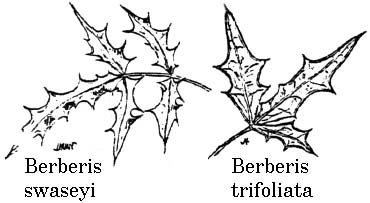B. trifoliolata X B. swaseyi Hybrids
by Bob Harms

The existence of B. trifoliolata X B. swaseyi hybrids is common lore among Texas botanists, often prefixed with 'rare.' But no serious studies or even attempts to determine how to recognize these hybrids have been published. Mentions in the literature generally attribute this claim to personal communication from a well known local authority; e.g., "According to M. C. Johnston (pers. comm.), B . swaseyi and B . trifoliolata hybridize in central Texas." (
Whittemore, FNA).
A class of clear hybrids is readily identifiable from the leaf structure, further supported by bracteoles of the inflorescence. The following table serves as a key:

The primary indicator is B. swaseyi's reduced lowest leaflet pair, often square or rounded, which is typically only 1–2 mm. above the base of the leaf. Sometimes these leaflets have detached, but in this event a clear annular abscission zone remains. (See also Basal Leaflets and Leaflet Reduction.) Not only are the lowest leaflets of hybrids not significantly smaller, they have the same form as the other leaflets, and the leafs have long petioles, often several centimeters long.
 |  |
| B. swaseyi | Typical hybrid leaves |
A 1983 Texas Native Plant Society News article "Berberis swaseyi - Facing Natural Extinction" (p. 1, by F. G. Breckenridge, III) presents a leaf drawing labeled 'Berberis swaseyi' which appears to be characteristic of a hybrid:

Given the typical keys which force a determination of B. swaseyi solely on a leaflet count basis (greater than 3), that hybrids are not generally recognized is an expected consequence.
Any plant satisfying the leaf structure condition, if it has bloomed, has also produced inflorescence bracteoles (bracts) that are essentially the same as those of B. trifoliolata, and in sharp contrast with the leaflike bracteoles of B. swaseyi.
 |  |
| B. swaseyi bracteoles | hybrid bracteoles |
As of April 2007 I have identified 48 clear hybrids, of all sizes (up to 7 feet tall), on our 50 acre tract in N. Hays County. I have also determined hybrids among the northermost Berberis swaseyi population at Lakeway in NW Travis County, in southern Hays County, above the Pedernales River in eastern Blanco County, and along the Devil's Backbone in Comal County.
But a number of plants that key out to either B. trifoliolata or B. swaseyi have features characteristic of the other species. Most salient of these features is the presence of filament teeth with putative B. trifoliolata and significantly reduced filament teeth with putative B. swaseyi. I interpret this as evidence of introgressive hybridization, probably having occurred for millennia in the B. swaseyi area (i.e., it would appear that B. trifoliolata has always been an associate of B. swaseyi).
